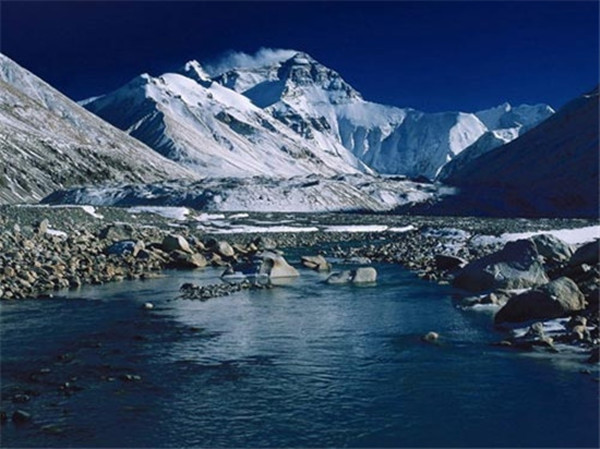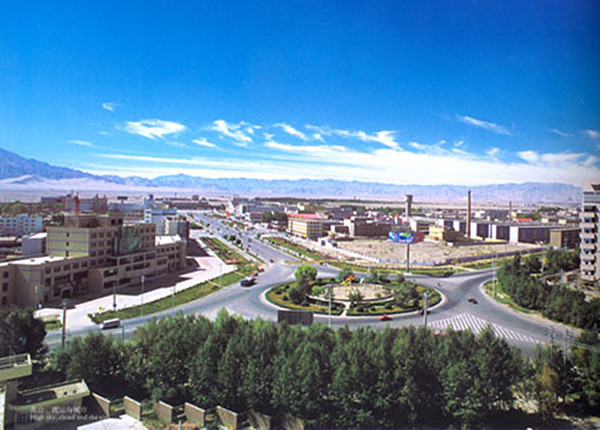The city of Golmud, a treasure basin of oil and minerals, including an abundance of salt (there are 20 salt lakes surrounding the city, some large, some small) and natural gas and oil reserves, as well as reserves of precious metals and precious stones, is the second-largest city in Qinghai Province. Golmud lies on the southern edge – roughly midway, east to west – of the Qaidam Basin, a large depression that lies south-southeast of, and almost adjacent to, the much larger depression, the Tarim Basin of Xinjiang Uyghur Autonomous Region (Xinjiang, for short). The two basins are separated by a thin mountainous strip of the Kunlun Mountains as they trail eastward (this phenomenon is called a yardang – see below), while the main expanse of the Kunlun Mountain range in this part of the Qinghai-Tibet Plateau skirts first south, then back north, or around the Qaidam Basin, continuing on eastward into the northwestern corner of Qinghai Province.

A Bustling Industrial City: Golmud’s Economic Base
The area around Golmud, as indicated, is blessed with extensive natural resources, which has led to the development of a chemical industry in Golmud which, among other things, produces magnesium, potassium and salt, prime components in the manufacture of artificial fertilizer. In fact, nearby Qarham Salt Lake supplies China’s largest production facility, located on the outskirts of Golmud, for fertilizer as well as for separately produced magnesium, potassium and salt for other industrial and consumer oriented purposes. Thanks partly to the fertilizer of Golmud (and partly to a special tree-planting initiative), the seemingly inexorable march of the Taklamakan and Gobi deserts has been arrested in many places, and in some instances, has been reversed. The more than 20 salt lakes in the area have earned Golmud the nickname of “China’s Salt Lake City”, as in the famous city of the same name located in the U.S. state of Utah.
Golmud, and the Qaidam Basin in general, are rich in deposits of coal and oil, as well as in natural gas. For example, Golmud’s natural gas reserves have been estimated at a trillion cubic meters. The city is also home to an oil refinery and various related petrochemical industries. In addition, this uniques treasure basin is rich in copper, gold, lead and zinc, as well as in jade and other precious stones.
An Emerging Cultural City
Golmud’s rocket-like industrial growth would inevitably provide the economic wherewithal to also grow the city as a cultural center, and this process has only just begun. The area around Golmud is no stranger to culture, however, as the ancient cities that ringed the Qaidam Basin, as an “upland” area to the Silk Road trade route (one route of the Silk Road followed the southern rim of the Tarim Basin just north of the aforementioned yardang – a yardang is an irregular ridge with a sharp crest barely separating two deep, round-bottomed troughs that have been carved out by wind erosion; in this case, the Tarim Basin to the north and the Qaidam Basin to the south). Moreover, the ancient city of Dunhuang (think of the grotto art of the Han (BCE 206 – CE 220) Dynasty period), which was a major stopping-off point on the Silk Road, lies only about 450 km northeast, as the crow flies, of Golmud.

Golmud is a modern city with a modern housing and transportation network, and with a budding education and cultural environment, thanks to the city’s rapid economic success. Already Golmud is the second-largest city in the province, and continues to expand as it prospers, branching out in other economic areas such as tourism, and, in time, the city is set to also become a major educational center for the region. Golmud is also a major hub on the Qinghai-Tibet Railway, which connects Qinghai Province (the cities of Xining and Golmud) to Tibet Autonomous Region (the city of Lhasa).
There are 25 ethnic minorities living in the greater admistrative region of Golmud, whereof Tibetans are the largest such group, followed by the Tu, the Hui, the Salar and the Mongols, while the Han Chinese majority group dominates. The area offers several other highlights such as Wangzhang Salt Bridge, the headwaters of the famous Changjiang (Yangtze) River, Tangula Mountain Pass in the Tangula region of the city, Geladandong Snow Mountain, Plateau Wild Animal Park, and the aforementioned yardang, a thin sliver of mountain range that has been all but covered in sand, with only the crest showing.